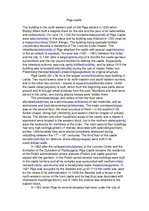The building in the north-western part of Old Riga started in 1220 when Bishop Albert built a hospital there for the sick and the poor of all nationalities and orders(šķira). On June 15, 1330 the fundamentals(pamati) of Riga Castle were laid(novietots) in this place and its building was finished in 1353 (lead by a mason(mūrnieks) Ditrich Kreige). The building being specially fortified (nocietināts) became a residence of The Livonian Order master. The inhabitants(iedzīvotāji) of Riga attacked the castle with special rage(tieksme) in the so-called( tā sauktais) Ten-year war (1481 - 1491) between the Order and the city. In 1481 after a siege(aplenkums) of 6 months the castle garrison surrendered and the city council decided to destroy the castle. Supposedly this intention(nodoms) was only partly fulfilled(izpildīts), and by about 1515 the building was renovated(rekonstruēts) during the rule of master Valter von Pletenberg thereby(tādejādi) preserving(saglabājot) its original structure.
Riga Castle (63 x 56 m) is the largest convent(klostera) type building in Latvia. Two round towers raise in its north-eastern and south-eastern corners, and in the other two corners – towers of square(kvadrātveida) stairs. Under the castle cellar(pagrabs) is built, which from the beginning was partly above ground and lit through small windows from the yard. Munitions and food were stored in the cellar, and during attacks horses were hidden there.
The premises(telpas) and cellars of the first floor were allocated(piešķirtas) as a storehouses(noliktavas) of war materials, and as workrooms and food storerooms(pieliekamais). The major premises(telpas) was on the second floor, the most luxurious of them – in the southern (St. Andrei chapel, dining hall (remteris)) and eastern (Hall for chapter of priests) blocks. The kitchen and other household areas of the castle, and a master’s apartment were located in the western block, but in the northern aisle(spārnā) were the bedrooms for members of the order.
…
Tulkojums no angļu uz latviešu valodu par Rīgas pili.


